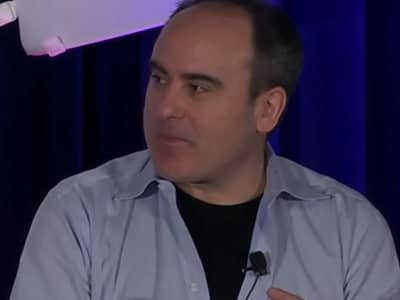

It may have come as a surprise for some to see OMERS Ventures CEO John Ruffolo take the Number 1 spot as Canada’s Most Powerful Business Person when Canadian Business published its “Power 50” rankings recently.
After all, 2013’s Number 1 spot was occupied by President and CEO of the Canada Pension Plan Investment Board, Mark Wiseman, who despite his slide to the Number 4 spot on this year’s list, still manages a $219 billion (with a “B”) investment pool, which is up from the $183 billion he managed only a year ago. Which ought to automatically cement his hold on the Number 1 slot, in terms of “power” rankings.
Wiseman’s Power 50 profile last year quipped, “Don’t talk to Wiseman about stakes smaller than $75 million—they aren’t worth his time.”
John Ruffolo, by contrast, manages a $200 million fund through OMERS Ventures, and has plenty of time for investments under $10 million, often as small as $500,000, seeking out companies that may not even be interested in an IPO.
So what happened? Something must have changed in the past year, at least in terms of how Canadian Business defines the word “power”.
The main thing Ruffolo and Wiseman have in common is that they are both pension fund managers in charge of extremely large pools of workers’ retirement money. And by sheer scale of funds managed, Wiseman is still clearly more “powerful” than Ruffolo. What the Canadian Business designation signals is a shift in momentum from one sector of the Canadian economy to another, from the historically larger and more significant mining and resource sectors to the technology sector, for which Ruffolo at the moment occupies and controls the most highly sought after and sophisticated vehicle for investment, the OMERS Venture fund, created specifically to invest venture capital in promising tech companies.
Ruffolo’s Number 1 ranking indicates that there’s a new sheriff in town, at least symbolically. But symbols are powerful motivators, and can have real-world effects.
At the Cantech Investment Conference in January, Ruffolo said to Mark McQueen, without naming names, that OMERS had five companies “in the hopper” for an IPO in 2014-2015. “We haven’t had five $100 million-plus IPOs I don’t think ever in the tech sector,” he said.
Canaccord Genuity Group has forecast that more than $400 million will be raised through Canadian tech IPOs this year, the largest amount raised for the sector in over 10 years.
What has obviously changed then in the past year, and what John Ruffolo’s ascent to “Most Powerful” status confers, is recognition for both a person and a sector that have been punching above their weight for the past several years and which may have more meaningful long-term impacts on the Canadian economy than their present size would indicate.
The mining and resource sectors account for a third of stock on the TSX, and have seen three straight years of decline, meaning that investors are looking elsewhere for growth. And while one sector’s loss doesn’t automatically fuel another’s gain in a zero-sum sense, investors looking for growth opportunities can’t help but notice that tech appears to have arrived, or at least matured enough to merit further investigation.
Last year saw a 31% decline in Standard & Poor’s TSX Composite Materials index, and a 36% increase for Canadian information technology companies, led by Constellation Technologies Inc. and Open Text Corp. The S&P 500 Technology index, by contrast, racked up a 26% gain in 2013, meaning that the Canadian tech sector has been outpacing its American equivalent.
The nearly 400 companies listed in the TSX’s innovation and tech sector had a market capitalization of $135 billion at the end of 2013, up 50% from the previous year. And as of now in 2014, the market cap of those same 400 companies stands at $155 billion, up 77% from the end of 2012. The innovation and technology sector of the TSX has grown 96% over the past two years.
Meanwhile, all eyes are on several privately held companies that are being cultivated to IPO: Hootsuite Media Inc., Desire2Learn Inc. and Vision Critical Communications Inc., all of which OMERS Ventures has invested in under Ruffolo’s guidance.
The idea is, keep the company private, using a proxy of a minimum of $100 million revenue size, and then go public, and doing it right and try to really establish the steady state, to make it a very good product.
But as we’ve seen with the rise and collapse of Canada’s most promising tech companies over the past couple decades, pinning hopes on the success of one or two big companies may lead to short-term windfalls for individual investors and a collapse in value for mom-and-pop investors followed by a decade of flight from the sector on the part of once-bitten analysts.
Part of it is optics. Still fresh in people’s minds when they think “Canadian tech sector” is Nortel’s 2009 bankruptcy coinciding with BlackBerry’s massive loss of handset market share.
When the Canadian Business Power 50 list was published last year, BlackBerry was on its way to becoming a punchline to yet another joke about the fall of yet another of Canada’s tech giants. But this year, John Chen snagged the Number 8 spot, in advance of what’s shaping up to be a remarkable resurgence for BlackBerry, at least if Project Ion and The Internet of Things pans out the way they’re projected to. And BlackBerry’s resurgence would be meaningful to the overall health of Canada’s tech sector as a whole, rather than yet another sad chapter in the book chronicling the long list of promising but failed Canadian tech companies.
What also bodes well, and also rationalizes Ruffolo’s ascent to the top of the list, is the shift in both strategy and attitude towards investing. The most important question is no longer, “How much money can we make short-term?” which was the overriding concern in the late 1990s. The most important question has become, “How will this investment develop this company in the context of Canada’s technology ecosystem?” The success of individual companies are seen to be linked within a larger context.
The tech sector today, to look at the big picture south of the border, represents almost 20% of the S%P 500, down from its peak at 35%, immediately before the dot.com crash in the year 2000. One can safely argue that this is a much healthier time for tech, a time in which the fundamentals are more important than the immediate ROI.
The difference in the tech ecosystem and the health of companies in Canada and in the United States, large and small, compared with the dot.com faceplant of the year 2000, is night and day. Whereas the impetus for investors 15 years ago was to reap a quick buck in an atmosphere of Tulipmania, the greater hope today is in the overall fundamental health of the tech sector and its long-term capacity for growth.
That shift in thinking is baked into how Ruffolo approaches potential investments, delaying the necessity for companies to go the IPO route until the fundamentals are in place.
“When I look back at some of the technology companies that did go public in the late 1990s, early 2000s,” he said, “and subsequently became stranded, one of the observations was that perhaps they were still just too immature from an infrastructure perspective, or a reporting perspective. The businesses hadn’t really reached a steady state. So the strategy became, if we could replace the proceeds that would be generated from an IPO and call it, or create ‘the private IPO’, where we would invest, in five cases over the last two years, the smallest one being approximately $20 million but the largest one being Hootsuite, actually, $165 million, the idea is, keep the company private, and using a proxy of a minimum of $100 million revenue size, and then go public, and doing it right and try to really establish the steady state, to make it a very good product, particularly for the institutions that typically buy that product. That was really the strategy.”
Another indicator of the tech sector’s health is that its CEOs have indicated a preference for remaining headquartered in Canada while expanding internationally. This was given its fullest expression in Ryan Holmes’ desire to create a “Maple Syrup Mafia” to rival Silicon Valley’s “PayPal Mafia”, while also pointing out that Vancouver is a nicer place to live.
It used to be that the best a Canadian tech hopeful could hope for was to exit or be acquired by an international or American company.
Also on the Cantech Investment Conference panel, Ungad Chadd, Senior Vice-President with the Toronto Stock Exchange, summed up the feeling about tech’s fundamentals and the overall health of the Canadian technology scene. “Whether these companies go public or not, getting more capital into great Canadian companies, it says to me there’s confidence. If the VCs have confidence as an investor class, then I think the other investors are going to have confidence as well, even on a delayed IPO that comes out further down the line.”
John Ruffolo’s “Most Powerful Business Person” status is a vote of confidence, both in him and in the Canadian technology sector. And as Chadd reminds us, if the investor class has confidence, then a critical mass of investment follows. It’s contagious.
Leave a Reply
You must be logged in to post a comment.





 Share
Share Tweet
Tweet Share
Share




Comment